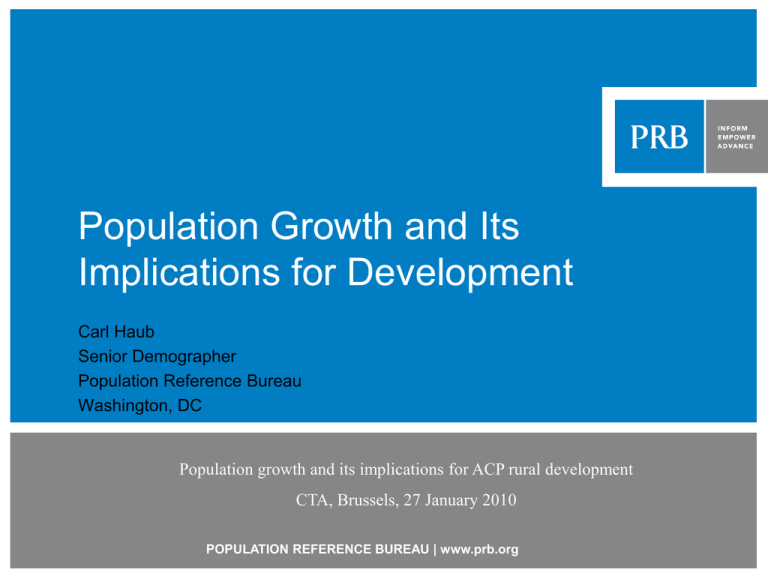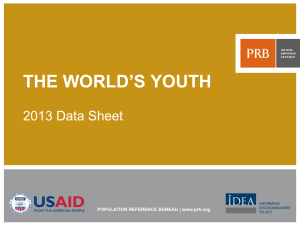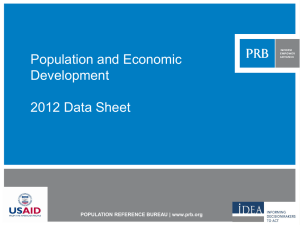
Population Growth and Its
Implications for Development
Carl Haub
Senior Demographer
Population Reference Bureau
Washington, DC
Population growth and its implications for ACP rural development
CTA, Brussels, 27 January 2010
POPULATION REFERENCE BUREAU | www.prb.org
Contemporary World Population Issues
All population growth is now in the poorest countries and areas.
Very young age structures in developing countries guarantee
this.
The situation is most acute in sub-Saharan Africa.
As essential as population projections are, their accuracy must
be continuously monitored.
Extreme aging will place enormous stress upon many
industrialized countries’ economies and societies.
Low fertility in developed countries presents South-North
migration opportunities.
Development is often impeded by a lack of reproductive rights.
In many ways, population change in the U.S. is not very
different from that of Europe.
© 2009 Population Reference Bureau. All rights reserved. www.prb.org
Global Population Growth Is Almost Entirely Concentrated
in the World's Poorer Countries
Billions
Global Population:
9
1900 = 1.6 Billion
8 World Population (in Billions): 1950-2050
2000 = 6.1 Billion
7
2011 = 7 Billion
6
5
4
3
2
Developing Countries
1
Developed Countries
50
20
45
20
40
20
35
20
30
20
25
20
20
20
15
20
10
20
05
20
00
20
95
19
90
19
85
19
80
19
75
19
70
19
65
19
60
19
55
19
19
50
0
United Nations Population Division, World Population Prospects, The 2008 Revision.
© 2009 Population Reference Bureau. All rights reserved. www.prb.org
The 20th Century Population Explosion Was a Result of the Mortality
“Revolution”
Life Expectancy at Birth (years)
80
70
60
50
40
Costa Rica
U.S.
Sri Lanka
30
20
10
19
50
19
55
19
60
19
65
19
70
19
75
19
80
19
85
19
90
19
95
20
00
20
05
19
27
19
21
0
Source: Costa Rica 1927 and 1950 - CICRED, others UN2006; Sri Lanka: ESCAP Country Monograph up to not incl. 1950, then UN2006
US: up to 1970 Vital Statistics books online; After 1970 NVSR 56:6 page 26
© 2009 Population Reference Bureau. All rights reserved. www.prb.org
Fewer and Fewer Young People and Future Aging
Developed Countries by Age and Sex, 2009
Age
80+
75-79
70-74
Females
Males
65-69
60-64
55-59
50-54
45-49
40-44
35-39
30-34
25-29
20-24
15-19
10-14
5-9
0-4
300
200
100
00
Millions
100
200
United Nations Population Division, World Population Prospects, The 2008 Revision, medium variant
© 2009 Population Reference Bureau. All rights reserved. www.prb.org
300
Large Numbers of Young People and Large Population Growth
Developing Countries by Age and Sex, 2009
Age
80-84
75-79
70-74
Females
Males
65-69
60-64
55-59
50-54
45-49
40-44
35-39
30-34
25-29
20-24
15 - 19
10 - 14
5-9
0-4
300
200
100
00
Millions
100
200
United Nations Population Division, World Population Prospects, The 2008 Revision, medium variant
© 2009 Population Reference Bureau. All rights reserved. www.prb.org
300
Population of the World’s Regions, 2009 and 2050 Projected
Millions
6,000
5,461
5,000
2009
2050
4,117
4,000
3,000
1,994
2,000
999
1,000
580
724
341
481
738
702
0
Asia
Africa
Latin
America/Carib.
North America
Europe
Population Reference Bureau, 2009 World Population Data Sheet
© 2009 Population Reference Bureau. All rights reserved. www.prb.org
The Total Fertility Rate (TFR)
Indice synthétique de fécondité (ISF)
The TFR is the average number of children a woman would
bear in her lifetime if the birth rate of a particular year were to
remain constant.
© 2009 Population Reference Bureau. All rights reserved. www.prb.org
How Are Projections Made?
The United Nations assumes that birth rates will decline so that
all developing countries will eventually average a European-like
1.85 children per woman.
That assumption is entirely dependent upon the additional
assumption that the use of family planning will rise to the same
level as that in Europe and North America, which the UN is very
careful to point out.
© 2009 Population Reference Bureau. All rights reserved. www.prb.org
The “Demographic Divide”
The Example of Nigeria and Japan
Nigeria
Japan
Population 2009 (millions)
153
128
Population 2050 (millions)
285
95
Lifetime Births per Woman
5.7
1.4
6,200,000
1,100,000
Annual Number of Births
Percent of Population Below Age 15
45
13
3
23
Life Expectancy at Birth
47
83
Infant Deaths per 1,000 Births
75
2.6
Annual Number of Infant Deaths
465,000
2,900
Percent of Adults with HIV/AIDS
3.1
-
Percent of Population Age 65+
2009 World Population Data Sheet
© 2009 Population Reference Bureau. All rights reserved. www.prb.org
Fertility Decline in Bangladesh and the United States, 1800 - 2006
Two Very Different Histories
Lifetime children per woman
7
6
5
4
3
Bangladesh
U.S.
2
1
18
00
18
10
18
20
18
30
18
40
18
50
18
60
18
70
18
80
18
90
19
00
19
10
19
20
19
30
19
40
19
50
19
60
19
70
19
80
19
90
20
00
20
06
0
Population Reference Bureau, NCHS, DHS surveys
© 2009 Population Reference Bureau. All rights reserved. www.prb.org
Total Fertility Rate, Selected Countries, 1975 and ca. 2009
Children per woman
8.7
7.9
7.4
7.1
1975
2009
6.8
6.7
6.2
6.0
5.8
5.5
5.1
4.5
4.4
4.1
4.0
3.9
3.3
2.8
2.1
2.0
1.6
an
iw
hi
C
Ta
na
l
zi
rk
ra
B
l ip
P
hi
Tu
n
pi
ui
G
ew
P
ap
ua
N
ey
es
a
ne
a
m
te
ua
G
G
ha
al
na
da
U
ga
n
er
ig
N
Y
em
en
1.0
United Nations, World Population Prospects, the 2009 Revision and 2009 World Population Data Sheet
© 2009 Population Reference Bureau. All rights reserved. www.prb.org
Total Fertility Rate, Major States of India, 2007
3.9
3.9
3.4
3.1
2.6
J&
2.0
2.0
1.9 1.9
1.9
1.7
1.6
er
al
Ta
a
m
il
N
ad
u
2.0
K
2.1
K
ar
na
ta
M
ka
ah
ar
as
ht
ra
2.3
K
ar
ya
na
G
uj
ar
at
O
ris
sa
H
ss
am
A
ih
ar
R
B
ra
de
sh
aj
as
th
C
an
hh
at
tis
ga
rh
U
tta
rP
IN
D
IA
2.4
Pu
nj
W
ab
es
H
t
im
B
en
ac
ga
ha
l
lP
A
r
ad
nd
es
hr
h
a
Pr
ad
es
h
2.6
el
hi
2.7
D
2.7
Sample Registration System
© 2009 Population Reference Bureau. All rights reserved. www.prb.org
The Slowdown in African Fertility Decline
Lifetime children per woman
8.0
7.0
6.0
5.0
4.0
3.0
2.0
Chad
Zimbabwe
Uganda
1.0
South Africa
0.0
1990 1991 1992 1993 1994 1995 1996 1997 1998 1999 2000 2001 2002 2003 2004 2005 2006
Demographic and Health Surveys and Statistics South Africa
© 2009 Population Reference Bureau. All rights reserved. www.prb.org
Use of Modern Contraception (Clinic and Supply Methods), mid-1990s
and Most Recent
% of Married women, ages 15-49
80
69.5
70
60
59.2
mid-1990s
ca. 2005-2008
50
40
33.6
30
32.7
24.9
23.6
17.9
20
14.4
16.7
16.4
13.2
10
10.1
9.7
8.1
0
Dom. Rep.
TFRs=
3.2/2.4
Philippines
4.1/3.3
Zambia
6.1/6.2
Haiti
4.8/4.0
Uganda
6.9/6.7
Madagascar
6.1/5.2
Ghana
5.2/4.0
Demographic and Health Surveys
© 2009 Population Reference Bureau. All rights reserved. www.prb.org
“Unmet Need” for Family Planning, Percent of Married/in Union Women
45
40.6
37.9
40
37.5
33.8
35
31.2
30
26.5
24.4
25
22.3
20.2
20
15.8
15
11.4
9.1
10
5
TFR=
2.4
3.3
6.2
4.0
6.7
5.2
20
07
si
a
do
ne
In
Do
m
.R
ep
.
20
07
er
20
06
Ni
g
20
08
er
ia
Ni
g
Ph
go
ili
pp
i
,D
ne
s
20
08
20
07
R
20
07
Co
n
Za
m
bi
a
20
06
al
i
M
20
05
-2
00
6
Et
hi
op
ia
20
05
Ha
it i
20
05
a
an
d
Rw
Ug
a
nd
a
20
06
0
4.0
Demographic and Health Surveys
© 2009 Population Reference Bureau. All rights reserved. www.prb.org
Wives’ Opinion on Who Should Make Household Decisions, Zambia 2007
Percent
Own health care
Large purchases
Daily purchases
Number of children*
60.3
49.3
46.4
43.7
41.8
34.0
33.0
31.7
19.0
20.1
13.7
3.1
M ainly wife
Demographic and Health Survey
Jointly
M ainly husband
* Question asked of husbands
© 2009 Population Reference Bureau. All rights reserved. www.prb.org
HIV Prevalence Before and After Nationally-representative Surveys Were
Taken, Selected sub-Saharan African Countries, 2003-2006
Percent of adult
population
25.0
21.5
Before survey
After survey
20.0
15.6
15.0
15.0
13.5
10.0
6.7
6.2
7.1
7.1
4.7
5.0
4.1
0.0
Zambia
Kenya
Central Af. Rep.
Cote d'Ivoire
Uganda
UNAIDS and Demographic and Health Surveys
© 2009 Population Reference Bureau. All rights reserved. www.prb.org
Future World Population Growth Will Be in Places Defined by
Countries as “Urban” While Rural Places Decline
Billions
9
World Population (in Billions): 1950-2050
8
7
6
5
Urban
4
3
2
Rural
1
0
1950
1975
2000
2025
2050
United Nations Population Division, World Urbanization Prospects, The 2007 Revision.
© 2009 Population Reference Bureau. All rights reserved. www.prb.org
What Are Urban Places?
Argentina
Canada
China
India
Japan
Maldives
Mexico
Niger
New Zealand
Norway
Peru
Senegal
United States
Populated centers with 2,000 or more
Places of 1,000 or more*
Cities designated by the State Council and other
places with density of 1,500 or more per sq. km.*
Specified towns with governments and places
with 5,000 or more and at least three-fourths of
the male labor force not in agriculture*
Cities (shi) with 50,000 or more*
Malé, the capital
Localities of 2,500 or more
Capital city and department and district capitals
Cities, towns, etc. with 1,000 or more
Localities of 200 or more
Populated centers with 100 or more dwellings
Agglomerations of 10,000 or more
Places of 2,500 or more, urbanized areas of
50,000 or more*
*There are some additional requirements regarding population size, population density
and specified urban characteristics
© 2009 Population Reference Bureau. All rights reserved. www.prb.org
Distribution of Population by Size, of Village, Town, or City, India, 2001
2,000 - 9,999
33%
10,000 - 49,999
11%
50,000 - 99,999
3%
100,000 - 499,999
6%
500,000 - 999,999
3%
less than 2,000
33%
1 million+
11%
2001 Census of India
© 2009 Population Reference Bureau. All rights reserved. www.prb.org
The “Demographic Divide” in Three States of India
Uttar Pradesh
Population 2001 (millions)
166
Population 2010
200
Literacy Male/Female (%)
69/42
Lifetime Births per Woman 2007
3.9
Modern Contraceptive Prev. ’05-06
29
Traditional Contra. Prev. ’05-06
14
Urban Population (%)
21
Percent of Population < Age 15
41
Households with Electricity (%)
32
Households in Permanent-type House
53
Households with Television
25
Households with Car, Jeep, or Van
2.2
Households with Two-wheeler
3.6
Households in One-room House
30
Percent of Children <3 Underweight
47
Bihar
83
99
60/33
3.9
29
5
11
42
10
41
9
0.9
10.4
43
58
Kerala
32
34
94/88
1.7
58
11
26
26
70
68
39
4.0
10.0
11
29
2001 Census of India, National Family Health Survey-3, Sample Registration System, PRB projections
© 2009 Population Reference Bureau. All rights reserved. www.prb.org
Households by Annual Income Groups, India, 2001-2002
"Aspirers" $1,900 4,249
22%
Middle class $4,250
- 21,275
6%
"Deprived" <$1,900
72%
Rich >$21,275
0%
National Council of Applied Economic Research, Delhi, 2005
© 2009 Population Reference Bureau. All rights reserved. www.prb.org
Annual Net Immigration, 1990 - 2009, Selected Countries
Thousands
900
800
Germany
Ireland
U.K.
Russia
700
600
500
400
300
200
100
0
1990 1991 1992 1993 1994 1995 1996 1997 1998 1999 2000 2001 2002 2003 2004 2005 2006 2007 2008 2009
-100
National Statistical Offices
© 2009 Population Reference Bureau. All rights reserved. www.prb.org
Population of Foreign Stock, Selected Countries, 1990 and 2010
Percent
23.2
20.5
19.6
1990
2010
14.1
14.1
13.1
10.4
9.1
8.4
7.5
6.5
6.5
5.6
1.7
0.9 1.1
a
Ja
pa
n
al
ay
si
a
M
.
.K
U
er
m
an
y
G
Sp
ai
n
ed
en
Sw
Ire
la
nd
Sw
itz
er
la
nd
0.9
Ja
m
ai
c
2.1
United Nations, International Migrant Stock, the 2008 Revision
© 2009 Population Reference Bureau. All rights reserved. www.prb.org
Population of Foreign Stock, World Regions, 1990 and 2010
Millions
70
61
49
51
50
28
16
19
7
7
4
Europe
Asia
North America
Africa
Latin
America/Carib.
6
Oceania
United Nations, International Migrant Stock, the 2008 Revision
© 2009 Population Reference Bureau. All rights reserved. www.prb.org
Migrant Remittances by Sending Country, ca. 2006
Billions of $US
64
15
13
9
U.S.
Germany
France
U.K.
8
7
Hong KongAustralia
SAR
5
UAE
5
Italy
4
2
Japan Bangladesh
World Bank, Migration Working Group
© 2009 Population Reference Bureau. All rights reserved. www.prb.org
Migrant Remittances by Receiving Country, ca. 2006
Billions of $US
23.5
22.5
21.8
13.6
3.5
3.3
2.3
India
China
Mexico PhilippinesPoland
Egypt
1.8
Nigeria Jamaica
0.9
0.6
Haiti
Uganda
0.1
Côte
d'Ivoire
World Bank, Migration Working Group
© 2009 Population Reference Bureau. All rights reserved. www.prb.org
Total Fertility Rates, Selected EU 15 Countries and the U.S., 1960 - 2008
Children per woman
4.0
Germany
3.5
Sweden
Italy
3.0
France
U.S.A.
2.5
2.0
1.5
1.0
1960
1963
1966
1969
1972
1975
1978
1981
1984
1987
1990
1993
1996
1999
2002
2005
2008
Council of Europe, Recent demographic developments in Europe and national statistics websites
© 2009 Population Reference Bureau. All rights reserved. www.prb.org
Total Fertility Rates, Selected New EU Countries, 1960 - 2008
Children per woman
4.0
Poland
3.5
Hungary
Czech Republic
Lithuania
3.0
2.5
2.0
1.5
1.0
1960 1963 1966 1969 1972 1975 1978 1981 1984 1987 1990 1993 1996 1999 2002 2005 2008
Council of Europe, Recent demographic developments in Europe and national statistics websites
© 2009 Population Reference Bureau. All rights reserved. www.prb.org
Population of Japan by Age and Sex, 1 December, 2009
Age
80+
75-79
70-74
Females
Males
65-69
60-64
55-59
50-54
45-49
40-44
35-39
30-34
25-29
20-24
15 - 19
10 - 14
5-9
0-4
6
4
2
0
2
4
6
Millions
Japan Statistics Bureau
© 2009 Population Reference Bureau. All rights reserved. www.prb.org
Population of Russia by Age and Sex, 1 January, 2009
Age
70+
65-69
60-64
Females
Males
55-59
50-54
45-49
40-44
35-39
30-34
25-29
20-24
15 - 19
10 - 14
5-9
0-4
10
8
6
4
2
0
2
4
6
8
10
Millions
State Statistical Bureau (GOSKOMSTAT)
© 2009 Population Reference Bureau. All rights reserved. www.prb.org
Average “Personal Ideal“ Number of Children, 2001 and
2006, Females Ages 15 - 24
3.0
2.6
2001
2006
2.5
2.7
2.6
2.4
2.2
2.4
2.1
2.3
2.1
2.1
2.0
2.0
1.8
1.6
2.3
1.7
1.6
1.5
1.0
0.5
0.0
Austria
Germany
France
Italy
U.K.
Portugal
Sweden
EU15
Eurobarometers, 56.2 and 65.1
© 2009 Population Reference Bureau. All rights reserved. www.prb.org
Percentage of Women, Ages 18-34 Giving “None” or “One” as Their
Ideal Number of Children, Selected Countries of Europe. 2001
None
25
One
19.1
20
16.6
14.0
15
12.6
12.2
12.2
10
8.4
7.0
5.5
5
3.3
3.7
3.1
4.0
3.8
0
Austria
Germany
Netherlands
France
Sweden
EU 15
Italy
Eurobarometer, 56.2
© 2009 Population Reference Bureau. All rights reserved. www.prb.org
© 2009 Population Reference Bureau. All rights reserved. www.prb.org
U.S. White non-Hispanic Population by Age and Sex, 2006
Age
80-84
70-74
Males
Females
60-64
50-54
40-44
30-34
20-24
'15-19
0-4
6
5
4
3
2
1
0
1
2
3
4
5
6
Percent
U.S. Census Bureau
© 2009 Population Reference Bureau. All rights reserved. www.prb.org
U.S. Hispanic Population by Age and Sex, 2006
Age
80-84
Males
Females
70-74
60-64
50-54
40-44
30-34
20-24
'10-14
0-4
6
U.S. Census Bureau
5
4
3
2
1
0
1
2
3
4
5
Percent
© 2009 Population Reference Bureau. All rights reserved. www.prb.org
6
Total Fertility Rate of U.S. and U.K. Ethnic Groups, 2007
Lifetime births per woman
3.0
3.1
2.5
2.1
2.1
2.0
1.9
U.S. Total
White non- Black non- Asian/Pac.
Hispanic
Hispanic
Islander
1.9
American
Indian
1.8
All
Hispanic
groups
Mexican
UK Native
Born
UK Foreign
Born
U.S. National Center for Health Statistics and U.K. Office of National Statistics
© 2009 Population Reference Bureau. All rights reserved. www.prb.org
Components of U.S. Population Growth by Ethnic Group, 2007 - 2008
Millions
1,881
Natural increase
Net immigration
999
889
471
368
274
201
160
204
69
U.S. Total
White nonHispanic
Hispanic
Black/Af. Amer.
Asian/Other
U.S Census Bureau
© 2009 Population Reference Bureau. All rights reserved. www.prb.org
The Association Between Poverty and Fertility, 2007
% Living below $2 per day
100
90
80
70
60
50
40
30
20
10
0
1
2
3
4
5
6
7
8
Average number of children per woman
Population Reference Bureau, Population and Economic Development Linkages 2007
© 2009 Population Reference Bureau. All rights reserved. www.prb.org
The Association Between Population Growth Rate and GDP Growth
Annual population growth rate, 1975 - 2004 (%)
4
3
2
1
0
-5
-4
-3
-2
-1
0
1
2
3
4
5
6
7
8
-1
Average annual GDP per capita growth rate, 1975 - 2004 (%)
Population Reference Bureau, Population and Economic Development Linkages 2007
© 2009 Population Reference Bureau. All rights reserved. www.prb.org
Thank You!
carlh@prb.org
© 2009 Population Reference Bureau. All rights reserved. www.prb.org






